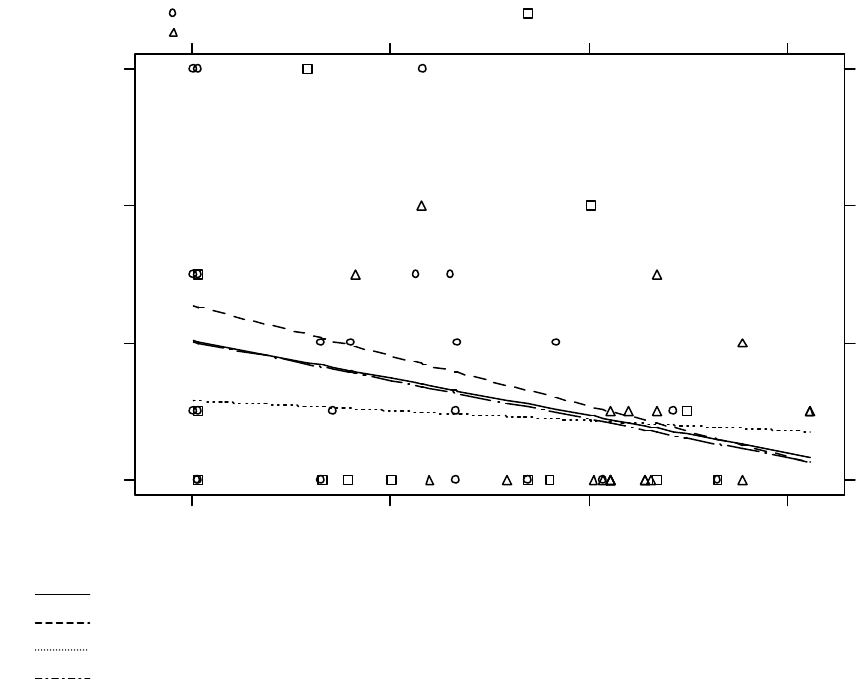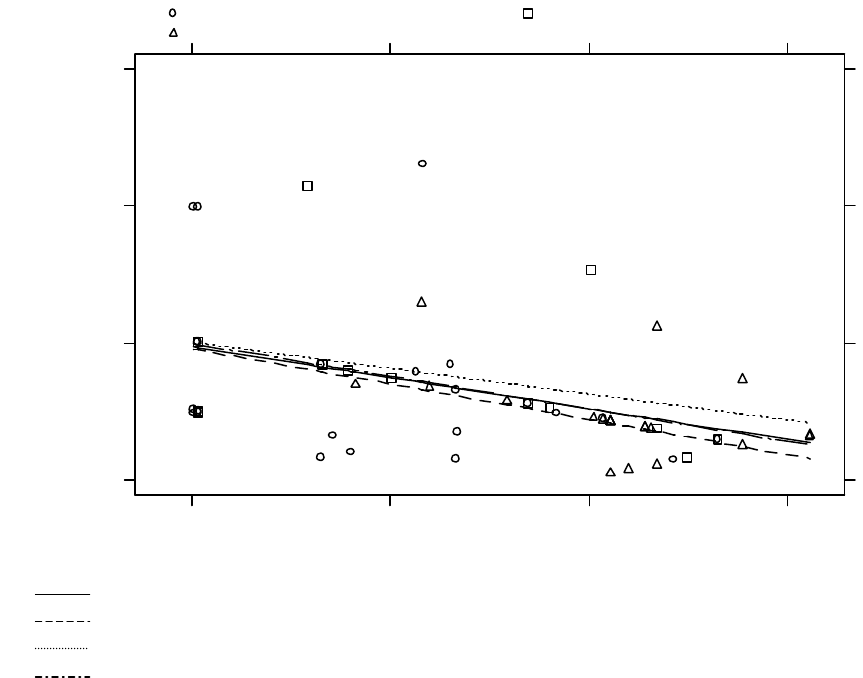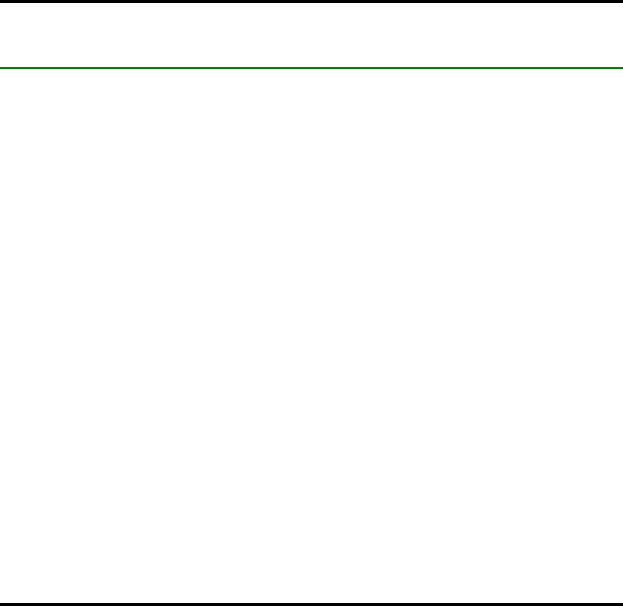Tsebelis G. Veto Players: How Political Institutions Work
Подождите немного. Документ загружается.


261
governments receive a score of 1, countries with a mixture of single and up to two parties in
government receive a score of 2, and countries with more than 2 parties in government receive a
score of 3. These scores reflect the situation prevailing in these countries for a substantially
longer period than the 10 years we have been studying so far. The only country requiring
additional explanation is Germany. The number 3 reflects the fact that, while the government
coalitions since the beginning of the 1950s involve only two parties, the Bundesrat has been
controlled by an opposing majority for significant periods of time.
INSERT TABLES 7.4A, B, AND C
Table 7.4 presents the correlation coefficients of the variables included in Table 7.3. The
three versions depend on whether Sweden is included with 375 annual laws (Table 7.4A), with
56 such laws (Table 7.4B), or excluded from the data set altogether (Table 7.4C). The reader can
verify that the correlation between all laws and significant laws is negative in two of the three
versions of the table, most notably the one that excludes Sweden. So, in two out of the three
versions, the expectation of negative correlation between significant and overall legislation is
corroborated.
More interesting, however, are the relationships between veto players and the number of
laws, as well as the relationship between veto players and agenda control by the government.
veto players correlated positively with the number of all laws, and negatively with the number of
significant laws in all three versions of Table 7.4. Similarly, as Doering has convincingly
demonstrated, agenda control by the government is negatively correlated with legislative
inflation (the number is positive in Table 7.4 because higher numbers indicate less control by the
government). Finally, the most interesting finding is that the number of veto players is highly
correlated with (the lack of) agenda control (again, in all versions of Table 7.4).
262
How can we interpret these findings? I think the positive correlation of veto players and
(lack of) agenda control with the total number of laws and the negative correlation of the same
variables with the number of significant laws point toward a difference in the very concept of
“law” among countries. “Laws” in countries with many veto players and low government agenda
control produce incremental changes of the status quo, while in countries with few veto players
and significant government agenda control, they produce sweeping changes.
But why is (lack of) agenda setting by the government correlated with the number of veto
players? The reader should refer back to Figure I in the Introduction, where I made the argument
that many veto players lead to the lower significance of agenda setting, because the winset of the
status quo is smaller, and so agenda control loses significance. Are the findings here in support
of this proposition? The answer to this question is negative, because Doering’s (1995a,b, c)
indicators refer to the institutional structure of these countries, not on the frequency specific
governments use such agenda control measures (to the extent they exist).
Is there any different argument for the correlation between veto players and government
control of the agenda? In fact, is it a coincidental relation or a causal one? Several arguments can
be made that it is not a mere correlation. While a causal argument attributing the existence of
veto players to the lack of agenda control is difficult, a strategic argument going from agenda
control to veto players is possible. In countries with strong government agenda control, party
negotiations for coalition governments will end up in a minority government or a government
with few veto players. Conversely, in countries without government agenda control, parties will
form oversized government coalitions in order to control the legislature. On the other hand, a
causal argument going from veto players to agenda control is straightforward: the existence of
many veto players makes them incapable of passing through parliament the many and significant

263
pieces of legislation required for agenda control. This argument considers agenda control to be a
collection of significant pieces of legislation. Consequently, we expect not to see it in countries
with many veto players. Finally, a third argument can be made: that veto players and agenda
control have common origins. The same sociological and historical factors that fragment a
country into many competing parties (none of which has a majority) make these parties
sufficiently suspicious of each other, so that they reject the idea of allowing whoever is in
government to have significant control over legislation.
Which one of the three explanations is closer to the truth? This is a major question for
further investigation. In order to address this question, one would have to collect data on the
adoption (and possible repeal) of the different agenda control mechanisms and analyze them in
relation to the governments that produced them. In other words, one would have to replicate this
study with agenda control as the subject matter.
Finally, how about the actual use of agenda control measures by different governments?
The expectation introduced in this book (Figure I) is that more veto players reduce the
significance of agenda control, consequently governments with more veto players would make
less use of such measures. Is there any empirical evidence to support this expectation? Again the
reference is in the work of Doering who more recently expanded his research to the actual use of
agenda control measures. Doering (2001) examining some 500 pieces of legislation from 18
West European countries multiparty governments (whether majority or minority) make less use
of agenda control measures (13.7%) than single party governments (20.7%).
118
CONCLUSIONS
118
Recalculations from Doering 2001: table 9.
264
I have presented the implications of the veto players theory when parties are located in a
one-dimensional space and analyzed data on significant pieces of legislation in sixteen Western
European countries. All the relevant expectations of the theory presented in the Introduction and
in Chapter 1 were corroborated by the data: The number of significant laws varies inversely with
the range of governments that produce them and in direct proportion to the difference between
ideological positions of the current and previous government. Duration of governments increases
the number of significant laws, but with declining returns. In addition, the residuals of the above
relationship are heteroskedastic and vary inversely with the range of the government coalitions.
The reason for this relationship is that a wide range is a sufficient (but not necessary) condition
for the absence of significant legislation.
The number of veto players is positively correlated with the number of overall pieces of
legislation in a country. This generates the expectation that the very concept of “law” differs
from one country to the next, with countries with a large number of veto players implementing
more incremental legislation. The positive relation between veto players and total pieces of
legislation and the negative relationship between veto players and significant pieces imply an
overall negative relationship between total number of laws and significant pieces of legislation.
The conclusion from this analysis is that now the missing empirical link between veto
players and a series of important features of parliamentary systems has been established. Many
veto players with big ideological distances between them means that legislation can only be
incremental. If an exogenous shock occurs, a government with many veto players with big
ideological distances among them cannot handle the situation and cannot agree on the necessary
policies (except if the public opinion is unanimous on the subject). Finally, the relationship
between veto players and agenda control that we identified here along with the relationship
265
between agenda control and executive power identified in Chapter 4 lead to the conclusion that
many veto players affect the relationship between government and parliament in Western
European countries. Many veto players are correlated with lack of institutional agenda control by
the government and lack of agenda control means weaker governments and stronger parliaments.
The reasons for the relationship between veto players and agenda control by the government
have to be more thoroughly investigated in the future. Finally, few veto players lead to the use of
the existing agenda control arsenal more frequently than many veto players, because the
significance of agenda setting declines with the number of veto players since the winset of the
status quo shrinks (policy stability increases).

266
FIGURE 7.1
Number of Important Laws by Ideological Range of Coalition
Numbers of Laws
range
Minimum Winning Coalition Minority Government
Oversized Government
-1.5 -.5 .5 1.5
0
2
4
6
All Governments: [Numbers of Laws = 1.21 –0.54RANGE]
Minimum Winning Coalition: [Numbers of Laws = 1.44 –0.73RANGE]
Minority Government: [Numbers of Laws = 0.93 –0.14RANGE]
Oversized Government [Numbers of Laws = 1.17 –0.56RANGE]

267
FIGURE 7.2
Residuals (Absolute Value) of Important Laws by Ideological Range of Coalition
Absolute Value of Residual
range
Minimum Winning Coalition Minority Government
Oversized Government
-1.5 -.5 .5 1.5
0
2
4
6
All Governments [ |residuals| = 1.26-0.44RANGE]
Minimum Winning Coalition [ |residuals| = 1.14-0.51RANGE]
Minority Government [ |residuals| = 1.44-0.37RANGE]
Oversized Government [ |residuals| = 1.27-0.47RANGE]

268
TABLE 7.1
Multiplicative Heteroskedastic Regression model of Significant Legislation
MODEL 1
(includes RANGE)
MODEL 2
(excludes RANGE)
Dependent Variable: Number of Significant Laws
Constant 1.1935***
(.2017)
1.2711***
(.2246)
RANGE -.4837***
(.0133)
Dependent Variable: The Squared Error Term of Number of
Significant Laws
Constant .7110***
(.1852)
1.0910***
(.1841)
RANGE -.7471***
(.1919)
N 59 59
Prob >
2
?
0.000 0.000
Likelihood-ratio test:
2
2
? = 17.85 Prob >
2
2
? = 0.0001
standard errors in ( )
* significant at the .05 level
** significant at the .01 level
*** significant at the .001 level
All tests are one tailed.
269
TABLE 7.2
Multivariate Models of Significant Legislation
(linear and ordered probit)
Variable Model 1
Model 2
Neg.
Binom.
M2
Model 2A
MWC
Model
2B
Minority
Model
2C
Oversized
Model 3
Neg.
Binom.
M3
Constant -.18
(.26)
.25
(.24)
-.89***
(.26)
-.27
(.47)
.29
(.85)
.81***
(.36)
.25
(.25)
-.9***
(.27)
Range -.27*
(.17)
-.33**
(.18)
-.20*
(.15)
-.63**
(.33)
-.06
(.50)
-.57*
(.36)
-.35**
(.19)
-.24*
(.17)
Abs(Altern) .54***
(.23)
.65***
(.23)
.23*
(.16)
.85***
(.33)
.73
(.83)
-.08
(.42)
.65***
(.24)
.25*
(.18)
Duration .35***
(.06)
Ln(Duration)
.84***
(.16)
.83***
(.16)
.91***
(.27)
.73*
(.45)
.84***
(.23)
.85***
(.17)
.83***
(.17)
Agenda -.19
(.80)
-.09
(0.69)
Corporatism .01
(.27)
.07
(.24)
Left -.01
(.16)
.01
(.11)
N 59 59 59 23 15 21 59 59
R
2
.525 .504 .635 .299 .493 .506
Adjusted R
2
.499 .477 .577 .108 .404 .449
Pseudo R
2
0.205 0.207
standard errors in ( )
* significant at the .05 level
** significant at the .01 level
*** significant at the .001 level
MWC: minimum-winning coalition
All tests are one tailed.
270
TABLE 7.3
NUMBER OF LAWS, IMPORTANT LAWS, VETO PLAYERS, AND GOVERNMENT
CONTROL OF LEGISLATIVE AGENDA
Country import.
laws
(work.
time)
laws/year veto
players
(qual)
veto
players
(numer)
agenda
control
(qual)
agenda
control
(numer)
Austria 3
121
2 1.79
-4
-.044
Belgium 7
49
3 4.29
-4
-.170
Denmark 5
165
3 3.57
-5
-.106
Finland 4
343
3 3.89
-5
-.148
France 8
94
2 1.57
-2
.333
Germany 2
83
3 2.19
-4
-.126
Greece 10
88
1 1
-2
.280
Ireland 2
35
2 1.78
-1
.519
Italy 1
264
3 4.70
-6
-.219
Luxembourg 6
66
2 2
-3
-.053
Netherlands 1
134
3 2.13
-7
-.527
Portugal 5
69
2 2.34
-3
.147
Spain 3
56
1 1
-4
.221
Sweden 9
375
(56 new)
2 1.82
-5
-.427
Switzerland 3
32
3 4
-3
-.135
UK 6
62
1 1
-1
.690
numbers important laws from this study;
numbers of laws, qualitative agenda control (with opposite sign) from Doering (1995)
veto players average
